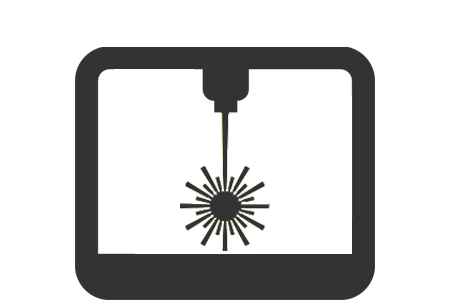I salvaged a steel frame with an aluminium plate on the top, and decided it would be an excellent base for a laser cutter. The outer dimensions of the plate are 700x1200 mm, it's about 5mm thick. The frame is 20mm box section.
14-08-16 OK, so I've now been working on the design for a while and realised that the steel frame is too restrictive for laser travel. I've bought an 80W CO2 laser from SPT lasers, and it seems silly to have a 1600m long laser on a 1200mm frame. I'm going to use the V-slot extrusions to build the frame and gantries, with a vaguely Lasersaur-ish look. I'll still be using the aluminium plate, but now repurposed as a pin bed. I've bought 4x NEMA 17 stepper motors with M8 leadscrews which I will use to raise and lower the bed.

I have a small CNC spindle, my idea is to temporarily mount that on my gantry instead of the laser and use it to drill holes that I can insert pop rivets into (inspired by Andy Slater). If I choose 20mm spacing that would be 58x33 = 1914 holes, definitely not a job I'd like to do by hand on a drill press, even if I had a drill press with a large enough throat...
For the optics, I bought a cheap set from Saite through eBay. I couldn't find CAD models for the parts anywhere so I measured them and uploaded models to GrabCAD.
Electronics - still a bit undecided here, I definitely want to be able to to raster etching as well as vector cutting. I have a PlanetCNC Mk2 controller board so would like to use that but don't know if I can get it to handle rastering. The LaserSaur board can now do it, but it's just running an Atmega328P which consumes GCODE so don't really see how this would be better.
Chiller - another combination of salvaged and bought parts. A 10L water tank is used for the header, then a 12V brushless water pump is followed by a flow meter. Before reaching the laser the water is chilled by passing through a serpentine copper microbore pipe, soldered to an aluminium plate. This plate is clamped to another thicker aluminium plate (with heat transfer compound in between) which has Peltier coolers on the other side. Each of the Peltier coolers has its own 12V fan and heatsink. The Peltiers are powered by a large (2kW) power supply from Delta Electronics - this beast can put out 35A at the required 12V. Output is controlled by a 0-10V analogue signal. The temperature of the water leaving the laser head will be monitored using a thermistor, and a PID controller implemented on an Arduino will regulate the PSU output. The Arduino will also provide a shutdown signal to the laser PSU if the chiller parameters (flow, temperature) go out of range.
CO2 laser cutter
Build in 'Laser Cutter Builds' published by Tim Butler, Aug 16, 2016.
A build which is based on a metal frame and aluminium plate which I salvaged from a skip. The frame is sized to hold 19" rack units so I'll build my control box into a 3U rack unit (also salvaged). The area available for the build is 700x1200mm. I'll sling a 60W CO2 tube under the base, the beam path will be initially upward into the enclosure.
-
-
-
- Build Progress:
-
- Build in Progress...
-
-
Build Author Tim Butler, Find all builds by Tim Butler
-
- Loading...
-
Build Details
- Build License:
-
- CC - Attribution - CC BY
Inspired by
-
Parts list
Qty Part Name Part Link Comments 1 80W CO2 laser tube http://www.laserwd.com/product_c80-80w-co2-laser-tube_912... Link Very good service from SPT lasers, hopefully the tube will arrive in one piece 1 CO2 laser power supply http://www.laserwd.com/product_spt-80w-co2-laser-power-su... Link 1 Laser head and mirrors from Saite http://www.ebay.co.uk/itm/DIY-CO2-Laser-Head-Si-Mirror-Zn... Link 0 Link

